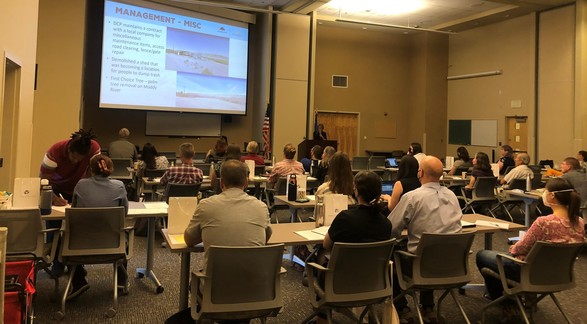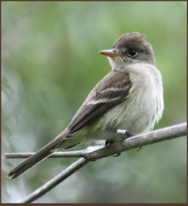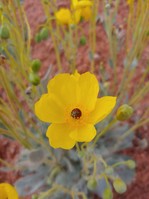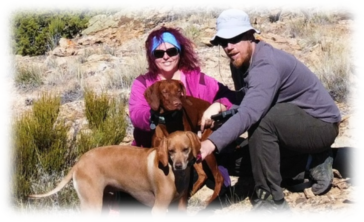|
|
The Clark County Desert Conservation Program (DCP) was established in 1990, and its purpose is to take action to ensure the survivability of covered species in the wild throughout Clark County. This collaboration with the cities of Las Vegas, Henderson, Boulder City, North Las Vegas, and Mesquite, and the Nevada Department of Transportation (NDOT) implements the Clark County Multiple Species Habitat Conservation Plan (MSHCP) to balance private landowner development with protecting the species that are native to the area.
The ultimate goal is to provide for the preservation and enhancement of native plant and animal species through research, acquisition of sensitive habitats, habitat restoration and public information and education. Together, everyone can learn to Respect, Protect, and Enjoy our beautiful desert.
One of the most well-known projects of the DCP is the protection of the wild desert tortoise through outreach and education, installation of maintenance and fencing along roadways to reduce tortoise mortality, and the Wild Desert Tortoise Assistance Line provided for construction workers to call when they discover a desert tortoise on an active construction site.
To learn more about the wide variety of species found throughout Clark County, check out the Species Account Manual.
|
|
THE MOJAVE MAX PROGRAM
Mojave Max is the official mascot for the Clark County Desert Conservation Program. He is a real live Desert Tortoise (Gopherus agassizii) who lives at Springs Preserve. Each year, elementary school students are invited to enter a guess as to when they think Mojave Max will emerge from his burrow. The winner of the Mojave Max Emergence Contest wins some great prizes and their entire class is invited to take a field trip to Springs Preserve to meet the real Mojave Max.
FUN FACTS:
- Desert Tortoises brumate (the reptilian form of hibernation) every winter, and emerge every spring.
- They spend 95% of their time underground to escape extreme weather.
- Burrows can be 3-6 feet down from the surface and in some cases extend 8 to 30 feet horizontally.
- All tortoises are turtles, but not all turtles are tortoises. Find out the difference on the Mojave Max website.
|
|
|
The DCP hosts an annual symposium which highlights the progress being made on the Multiple Species Habitat Conservation Plan (MSHCP). This year, 18 presentations were made, ranging in topics from Predator and Prey Dynamics to Avian Surveys to The Search for the Mojave Poppy Bee--and many interesting subjects in between. All presentations from past symposia (including the most recent) are available on the DCP website. Presenters were all directly connected to the work of the MSHCP, and hailed from the DCP team, DCP contractors, partner agencies, consulting firms, and non-profit non-government organizations (NGO's). This symposium is open to the public, and is held in August of each year.


The Southwestern Willow Flycatcher (Empidonax traillii extimus) is listed as Endangered under the Endangered Species Act and is a MSHCP Covered Species. It is a small migrant bird (about 5.9” in length). It is grayish-green on the back and wings, with a whitish throat, light gray-olive breast and pale yellow belly. The top of the beak is dark and the lower part is lighter in color.
It is an insectivore (eats only bugs), which it finds in dense vegetation. The southwestern species of the willow flycatcher is found in Southern Nevada, and other southwestern states. In Clark County, it is primarily found in the Virgin River and Muddy River areas. It may also be found in the Meadow Valley Wash, the Las Vegas Wash, and the Colorado River mainstem.
Clark County has established Riparian Reserve Units to restore and preserve desert habitats for this and many other birds.
|
FUN FACT:
These birds are tiny but territorial. The males try to intimidate other birds by tail-pumping and bill-snapping. If that doesn’t work, they will simply chase intruders away.
|
|

The Las Vegas Bear Poppy (Arctomecon californica) is classified as a State of Nevada Critically Endangered Species. It has several yellow flowers per stem, and is found in the Mojave desert scrub and salt desert scrub habitats on gypsum soils. It is primarily found in elevations between 1,300 and 2,700 feet in southeastern Nevada and northwestern Arizona--with the majority of populations occurring in Clark County (in the Las Vegas valley).
Photo: Stef Ferrazzano
|
FUN FACT:
Although this species is only native to two areas, Clark County, NV and Mojave County, AZ, it is also found in Washington County, UT, where it was introduced by seed.
|
|
"DESERT BEAUTY"
PHOTO CONTEST
Want to win a cool DCP tee and have your picture featured in a future newsletter? Send us your picture(s) of desert beauty in Clark County!
To submit your entry, email your photo to: DCPOutreach@ClarkCountyNV.Gov.
Be sure to include your name, where the picture was taken, and the date of the picture.
One WINNER will be chosen each month and their photo will be used in our newsletter. In addition to having their photo included in The DCP Habitat, the winner will also receive a prize pack with a Desert Conservation Program T-shirt and other logo items.
Our first “Desert Beauty” pic (featured in the header of this newsletter) was taken by the DCP Public Outreach Coordinator at the Springs Preserve in April, 2022, during the Earth Day event.

|
ATTENTION CONSTRUCTION WORKERS
Desert Tortoises are protected by U.S. Law!
If you spot a desert tortoise on your construction site, there are a few simple steps to take to have it safely and legally removed from the site:
- Carefully pick up the tortoise with one hand gripping the right side and the other hand gripping the left side of its shell.
- Gently place it in a clean, well-ventilated box or bin, and leave it uncovered.
- Gently move the box/bin to a shaded area, or a safe place indoors.
- Call our hotline at 702-593-9027 and provide the location of your construction site, and details as to where the tortoise is being held.
A member of the DCP team will respond within 24 hours to pick up the tortoise free of charge and safely relocate it to a conservation habitat.
|
|

Kimberley Jenkins is the Principal Environmental Specialist for the Clark County Desert Conservation Program (DCP). Originally from Salem, New Hampshire, Kimberley received her Bachelor of Science in Zoology from the University of New Hampshire, Durham.
Kimberley has been a Las Vegan for over 21 years. She started her career working on a variety of desert tortoise research topics related to the study of disease and reproduction. She spent several years working as a contractor focusing on threatened and endangered species evaluations, project compliance and permitting, and preparation of environmental documents in accordance with the National Environmental Policy Act (NEPA).
She joined the Clark County team in 2014 when she was hired into the position she holds today. Her primary roles are to serve as the project manager for the MSHCP Amendment, and oversee day-to-day operations of the DCP.
Kimberley met her husband, Chais, while hiking Mt. Charleston in 2005. They have been married since 2009 and enjoy spending their free time hiking and camping with their two fur babies, Ansel and Sylvan.
|
|
|
|
|
|